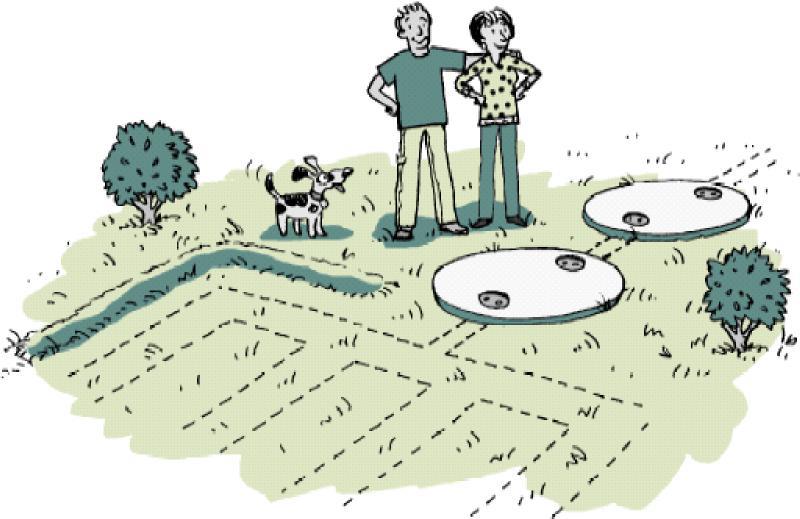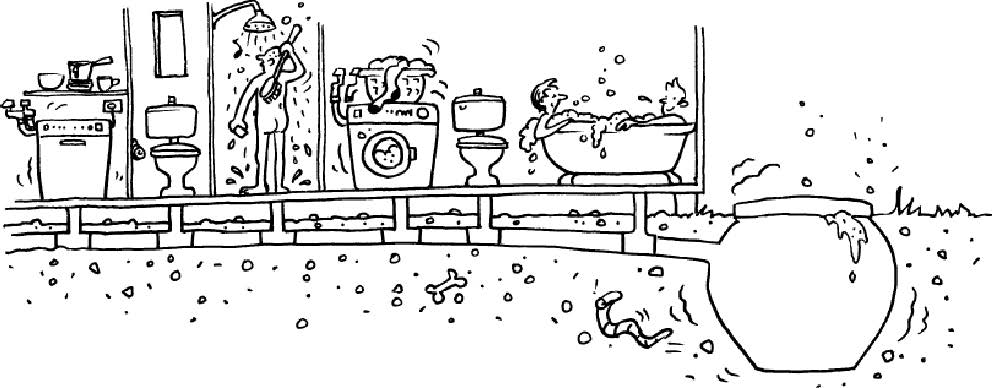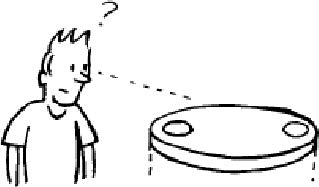Maintaining Onsite Effluent Disposal
|
What are owners responsible for?
- Ensuring their systems tank does not leak.
- Ensuring there is no run off from their systems drains.
- Getting the system fixed promptly if it is not functioning efficiently.
- Ensuring the system is fully maintained.
- Ensuring it is inspected regularly.
- Getting the tank pumped out when it becomes too full to process the flow going into it.
- Obtaining Council approval for onsite sewage management system installations or changes.
|

|
 |
Failing sewage management systems can:
- Overflow back into your home;
- Cause mosquito and odour issues around your home;
- Cause health issues to family and neighbours;
- Degrade the environment, especially waterways;
- Reduce the value of your property; and
- Be very expensive to repair.
|
|
IS YOUR SYSTEM HEALTHY?
CLUES
✓ No odours outside the house.
✓ Toilets flush easily and quickly.
✓ Water goes quickly down drains.
✓ The tank has been pumped out in the past five years.
✓ The tank has been checked in the past two years.
✓ The wastewater load from house has increased significantly
✓ No rampant weed growth downhill of the system.
✓ No soggy ground around the property on dry days
|
IS YOUR SYSTEM SICK?
CLUES
✓ The air around the system smells – usually like rotten egg gas.
✓ The toilets are slow to clear or keep backing up and overflowing.
✓ Drains are slow flowing or have a foul odour.
✓ There is a mosquito problem near the tank or vents.
✓ The area around the tank or drains is soggy and slow to dry.
|
COMMON CAUSES OF SEPTIC TANK PROBLEMS

You may have an ATU
If you have newly purchased a house you may have an Aerobic Treatment Unit (ATU). These look like Septic Systems but they aerate and chlorinate sewage to treat it at a higher level. You should have received a maintenance contract when purchasing the property as these are a requirement for this kind of system to ensure they are working optimally. Every ATU requires servicing every 3 months by law in the West Australian Code of Practice. If you think you have an ATU and no service contract contact a plumber or your local council officer and they can advise you on how to find qualified servicers.
Overuse of water
Sewage management systems do not respond well to shock loads. In the case of an older septic system, for example, three or four loads of washing completed in quick succession will flood the tanks. Long showers, leaking toilets and dripping taps can all lead to excessive pump out bills and potential overflows from the system.
Detergents and chemicals
The bacteria within the system can’t break down detergents and chemicals and may in fact be killed by them. This stops the tank being able to digest effluent and may result in odours. Hospitals and nursing homes reliant on onsite sewage management systems often inadvertently introduce substances such as antibiotics and other drugs into the system.
Build up in Tanks and drains
Many septic systems may be very old and possibly built of bricks or cement slabs. This means tree roots or sand may have blocked drains. The system may also have not been pumped out in a long time meaning the primary and even secondary tanks may be full of solid sludge that reduces the systems holding capacity and efficiency.
Desludging
If your system is smelly or the toilet is backing up, this is often a sign that the tank is overdue for a pump out. The tank needs desludging if the levels of scum and sludge are high. Local pump out service providers are listed in the Yellow Pages under “Septic Tank Cleaning Services” or "Controlled Waste Contractors".
 2023 DWER approved Waste Contractors
2023 DWER approved Waste Contractors
Yellow Pages

An onsite sewage management system should be inspected every 1-2 years and pumped out every 3-5 years.
- Tanks need desludging because as the level of the solids rises in the tank, the wastewater has less time to settle properly and so solids flow into the holding well and generate odour. How often you pump out a system depends on how large the tank is and how many people use the system.
- When contractors pump out tanks, a small volume of effluent is left in the tank to ensure tanks “don’t float”. Bacteria levels in the tank will be restored as soon as wastewater enters the system again.
- Your contractor will ensure the pumped out wastewater and solids are disposed of correctly as they must always be disposed of at an approved disposal or treatment site.
TIPS TO AVOID TROUBLE
- Check the tanks volume of wastewater. This should be done particularly after very heavy rain events. If the volume rises dramatically during this time storm water may be entering the tank and the seals of the system looked at.
- During dry weather, place pressure with the foot on the soil and turf around the perimeter of each tank. If you notice the soil/turf sinking, this could indicate a leak from the tank edges.
- Look for excessive grass growth around the inlet and outlet points of the tank. This will indicate cracks in pipe joints to the tank.
- Listen for water entering the system when all taps in the house are turned off. This may indicate a leak within the house, or entry of storm or ground water.
- If in the evening there are mosquitos around your drains or the area of an above ground septic tank the seals of the tank may not be effective.
 |
Magic enzymes...do additives work?
There are many septic system additives such as enzymes and cleansers available on the market. The truth is, these are not necessary and may harm the system. A well maintained system which has the correct amount of wastewater entering the system for its capacity should not need these additives. No amount of additives will help a tank if what it really needs is to be pumped out.
Flushing or adding a small amount of brown sugar may help good bacteria repopulate the system if it has been affected by chemicals or bleaches. Adding a small amount of Builders Lime to the system may also help balance out an acidic pH and neutralise odours after a pump out.
|
LANDSCAPING AROUND ONSITE EFFLUENT SYSTEMS
Shallow-rooted plants, climbers, and shrubs can be grown in the surrounding areas of a system but only plants with roots less than 30cm should be planted directly over an absorption trench area. It’s also advisable to choose plants that can thrive in a salty environment or a more acidic pH level as the area near a system will tend to this over time. Gypsum can be added to soils to improve drainage and builders lime added to raise the pH of soils.
Fast-growing trees like cedar and weeping willows should be strictly avoided. If you plant a tree that can grow up to 5m, you can expect its roots to grow out to a distance of 5m from the tree’s base, and should have an appropriate distance from your drains. A horticulturalist should be consulted to find out a trees root growth diameter but they should never be planted between a septic tank and drain field or close to a leach drains inlet side as roots will seek the water and nutrients in the drains. Fruits and vegetables should not be planted over the absorption field as eating them could put you at risk of bacterial contamination.
Some plants that can work well near septic systems drain fields (be careful near piping) are:
|
Climbers
- Bougainvillea
- Snake Vine
- Jasmine
- Happy wanderer
- Glory Vine
- Japanese Honeysuckle
Groundcovers
- Oyster plant
- Royal mantle
- Blue star creeper
- Lily Turf
- Native violet
- Perennial Aster
- Scaevola
- Hibertia
|
Grass
- Sedge
- Lawn turf grass
- Weeping grass
Shrubs
- Swamp Hibiscus
- Jasmine
- Tea-tree
- Oleander
- Abelia
- Papyrus
- Patersonia
- Juncus
- Ferns
- Restio
- Baumea
|
EASY TIPS ON HOW TO MAINTAIN A HEALTHY PUMP-OUT SYSTEM
|
Around the Tank
• Avoid planting trees within 4 metres of your septic tanks. Roots could, in the future, create cracks in the tank sides.
• Don’t connect ‘clean water’ outlets, such as stormwater drains, to tanks.
• Don’t drive or park over any part of the system.
• Check baffles and T-junctions within tanks. Replace as necessary (material can be purchased from nearby hardware stores and installed by a plumber).
• Keep tanks clear of vegetation.
• Ensure tanks are sealed, and that all air vents are covered with gauze, to prevent mosquito and insect access to the tanks.
• Repair leaking taps as soon as possible to reduce water load on system.
|
In the Laundry
• Do your laundry in small doses - this will avoid flooding the system with large amounts of water at one time.
• Use low-phosphorous detergents. Phosphorous is a major pollutant of waterways and causes algal blooms.
• Avoid blockages in the system by installing a lint filter on the washing machine – a stocking over the outlet hose will suffice.
• If you’ve got a blocked drain, use boiling water or an electric eel to clear the line, rather than caustic soda.
• Use front loading washing machines, as they use less water.
• Wash only full loads. Hand washing of small items saves water.
• Use liquid detergents, or highly biodegradable powder detergents if liquid is not available.
|
|
In the Kitchen
• Use a sink strainer or under sink grease trap- this prevents particles of food getting into the septic system and slowing down the process.
• Don’t pour oils and fats down the sink - they solidify and may block the system. Instead, put them into a container such as a milk carton and throw out with the rubbish.
• Wash only full-loads in the dishwasher.
• Install low-flow taps.
• Don’t use a garbage disposal unit – no food products should be disposed of in the sewage management system.
• Use a minimal amount of drain cleaners.
• Repair leaking taps as soon as possible to reduce water load on system.
|
In the Bathroom
• Install a low-flow shower head to save water.
• Consider installing a dual flush toilet.
• Minimise the use of commercial cleaners - these can interfere with the bacterial breakdown in the tank. Instead, try using baking soda, or a very mild detergent solution.
• Don’t flush anything down the toilet that could clog up the system, e.g. grease, tampons, condoms, paper towels, plastics, or cat litter. These items will quickly fill up the tank, decreasing its efficiency and making it necessary to pump out more often.
• Verify that the toilet isn’t leaking by placing a small amount of food dye in the cistern. If it appears in the toilet bowl within 30 minutes, your cistern is leaking. Contact a plumber to have this fixed.
• Repair leaking taps as soon as possible to reduce water load on system.
|
|
|
I’ve Done Everything I Can and I Still Have Problems .....
If you have attempted all suggested trouble shooting tips and you are still having problems with your system, it may be time to replace it. First it is advisable to have a Controlled Waste Contractor or Plumber look at the system then Contact Council’s Environmental Health Officer (95749347) for information if it needs amending and replacing and for advice on what system will suit your needs.